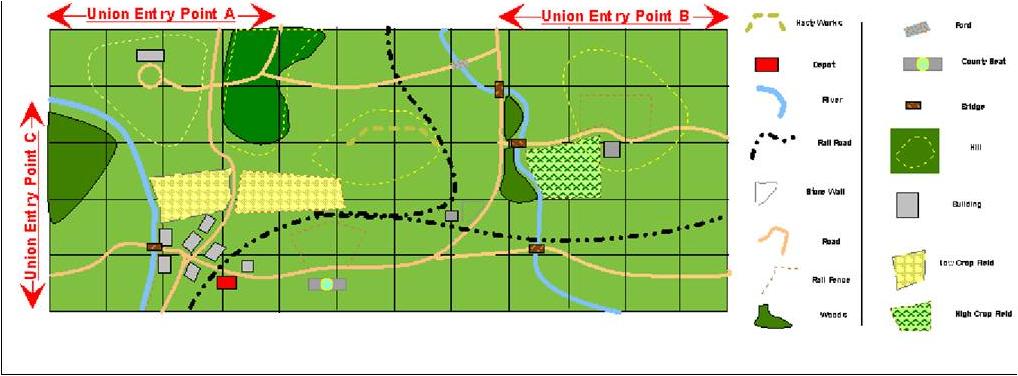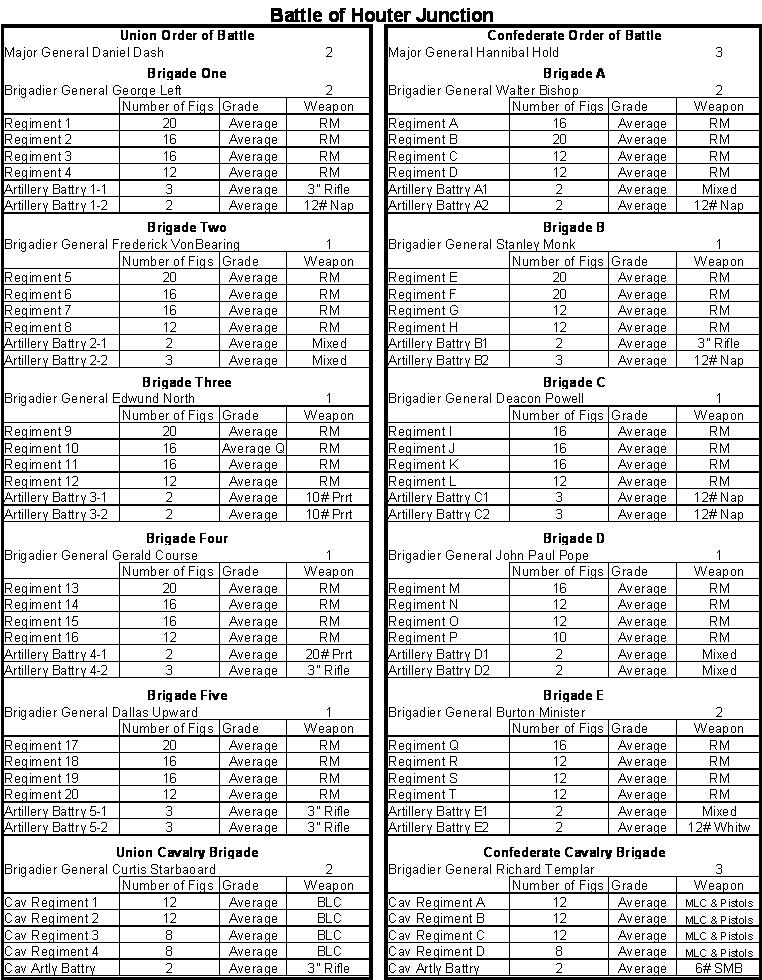Fictional Scenario Originally Developed for Little Wars Game Convention April 2002
Civil War Scenario for Johnny Reb III
Little Wars Judges and Play Testers
Scot Gore, Mike Askins, Kevin Killian, Bruce Wiese, Jon Treadwell, Dave Page, Terry Miller, and Soren Christiansen
Background
Confederate:
Converging Union brigades are approaching the local railroad hub and county seat of Houter Junction. Vital war supplies and contraband must be evacuated before the Yankees overrun the rail lines and crossroads. Confederates soldiers have been deployed in defensive positions to delay the approach of the enemy. Confederate forces must hold the invaders back long enough for the supplies to escape to safer territory.
Union:
Through skillful use of your naval forces you have deployed your brigades in a fashion that renders Lancaster County untenable for the secessionists. Scouts report that Confederate forces have deployed in the town of Houter Junction to make their stand. If you can crush these isolated units here and now, before they can retreat to friendly lines, the war in this region could be shortened by months. Deploy your forces for attack.
Victory Conditions
Confederate:
1 point for every cargo BB that exits off the right side table edge or the Union entry table edge.
Union:
1 point for every full stand of infantry, cavalry, or artillery removed from play. Stands that rout off the table are considered removed from play. Union forces receive 10 bonus points for hoisting Old Glory above the county seat before the end of turn 8.
Deployment
Confederate:
Confederate forces deploy first. Confederate brigades may be placed anywhere on the tabletop, in any formation. The only exception to this is that no Confederate stand may be placed within 15 inches of a Union entry point.
Union:
Union forces enter the table from off board. Union entry points are marked on the map below. Regiments and batteries may move onto the table in any formation. Entry points have the following limitations.
Entry Point A: Up to 3 Brigades of Infantry or Cavalry
Entry Point B: Up to 3 Brigades of Infantry or Cavalry
Entry Point C: Up to 2 Brigades of Infantry or Cavalry
Scenario Special Rules
Contraband Loading:
At the start of the scenario, confederates players have 55 units of contraband and supplies. The contraband and supplies will be represented by 55 BBs in a box labeled depot. For each 4 stand infantry regiment (up to a maximum of 3) in contact with the Depot roll 1D4 in the movement phase. Cavalry regiments may replace one or more infantry regiment, however they only roll 1D3 for the amount of cargo they load each turn. The die roll result is the amount of cargo loaded by those regiments in the turn. Regiments may choose to load the cargo onto the train, into the wagons, or onto pack mules. All cargo from each die roll must be loaded in its entirety onto the chosen vehicle. The trains, wagons, and mules may only be loaded if they are within 1” of the Depot.
Train Movement:
In the mark order phase the confederate player should mark the train either Hold or Move. With a Hold order the train remains stationary and cargo may be loaded that turn. With a move order the train moves 1D6 inches in either direction along the track. Once the train has begun to move it must continue in the same direction until it stops. Trains can accelerate in subsequent movement phases by rolling 1D6 and adding the result to the current speed. The train’s top speed is 24 inches per turn. The train may exceed its maximum speed at the risk of catastrophic failure. For each inch of speed over 24 inches there is a 20% chance that something on the train will fail. If a fail result occurs, the train moves ½ it’s current speed and comes to a stop for the remainder of the game. If this movement takes the train off the table edge, the train stops at the edge. Trains can slow by ½ their total speed per turn until moving slower than 10 inches, the next turn they can move any distance between 0 and 10 inches. Moving trains may not have cargo loaded on them during the movement phase. If a moving train crosses a breached track, it becomes derailed and may not move for the remainder of the game.
Atacking A Train:
Small arms fire cannot harm a train. Infantry may charge a train moving 10 inches per turn or slower. Cavalry cannot charge a train. For impact purposes, treat the train as artillery (no flank or formation mods). The train may be supported in impact by infantry in the same manner as artillery. If a unit of enemy infantry, artillery, or cavalry is astride a section of track that a train crosses during it’s normal movement, resolve an immediate impact. The trains impact roll is favorably modified by its current speed. The unit enjoys and suffers all normal impact modifiers. If the train wins resolve results for the unit on the impact loss table. If the unit wins the train is derailed at the impact point and may not move for the remainder of the game.
Artillery can target a train. Trains have +3 DRM target modifier and a –1 DRM target modifier for each 5 full inches of speed. Trains will suffer the full flank fire DRM from artillery astride a straight run of track whose fire line follows the spine of the train model. For each artillery hit on the train roll on the following table.
| Result | Effect |
| 2 | Train Explodes |
| 3 | Coal Car Hit - Train will slow 1D6 per turn until speed reaches zero |
| 4 | Cargo Hit - Lose 1D6 of Cargo (empty train - no effect) |
| 5 | Moderate Hit - Lose 1D6 of Speed and 1D6 of Max speed. No acceleration next turn. |
| 6 | Minor Hit - Lose 1D6 of speed. No acceleration next turn |
| 7 | Re-Roll. Two 7’s in a row means the shot bounced off. |
| 8 | Minor Hit - Lose 1D6 of speed. No acceleration next turn |
| 9 | Moderate Hit - Lose 1D6 of Speed and 1D6 of Max speed. No acceleration next turn. |
| 10 | Cargo Hit - Lose 1D6 of Cargo (empty train - no effect) |
| 11 | Coal Car Hit - Train will slow 1D6 per turn until speed reaches zero |
| 12 | Train Explodes |
Wagon Movement:
Wagons move as limbered heavy artillery. If a wagon moves off road then there is a 20% chance that it will have a mechanical failure of some kind. Fail results always occur at ½ the total movement distance. If a fail result occurs, roll 1D6, add 1 to the die roll for each dead crewmember. The result is the number of turns before the crew can repair the failure and begin moving. Once they start moving if they are still off road a fail roll is required for the turn.
Supply Wagon Road Open Broken Woods
Movement Rate 12 6 3 none
Attacking A Wagon:
Wagons are treated as limbered artillery for both small arms and artillery fire. Wagons have 4 man crews and 4 horse teams. Horse and crew hits are as artillery. Wagon crews have base ML of 4.
Mule Team Movement:
Mule Teams move 10 inches per turn, regardless of terrain, with the exception rivers, which cost them 2” of movement for every 1” moved in the water.
Attacking A Mule Team:
Mule teams are treated as skirmishers for both small arms and artillery fire. Mule teams have 4 man crews and 3 mules per stand. For each hit on a mule team roll 1 die 6. Results of 1-4 are crew hits, 5-6 are mule hits. For each mule killed 1/3 (round up) of the cargo carried by the stand must dropped on the tabletop. Wagon crews have base ML of 4.
Cutting Rails:
Any unit may cut rail lines in the same manner and time as building hasty works. Cavalry must dismount to cut rail lines.
Example: To cut rail lines a unit must roll it’s BMP or better on a D6. After 2 times the units BMP the rail lines are cut at that point.
Repairing Rail Lines:
Rail lines may be repaired by the trains crew by stopping adjacent to the cut and spend 2D6 turns. If any enemy units are within one foot of the repair job the crew cannot work and the turn does not count toward the repair time.
Hoisting Old Glory:
Any Union regiment that can spend one entire turn in contact with the County Seat building without taking fire, engaging in impact, engaging in melee, or moving for an entire turn will raise Old Glory above the county seat for all Secessionists to see.
Artillery Brigading:
Artillery may only be fire brigade with sections from the same infantry brigade.
Artillery Ammo:
Artillery ammo will be limited. Each gun will be given a specific number of shot and canister rounds at the beginning of the scenario. Roll 2D6 to determine the number of rounds available. The controlling player may elect to take the rounds Cannister or Regular as they see fit. BB’s and other tokens will represent the rounds. They will be stored in matchboxes, each time a gun is fired the appropriate round type is tossed to the opposing player. When the matchbox is empty the artillery is out of ammo. Each side will have one artillery ammo wagon represented on the table, ammunition can be replenished at an ammo wagon until its supplies are exhausted.








This scenario is a hoot! A very innovative setting by Scot. The
Confederate players must hold the line until they think there are
sufficient accumulated supplies to ensure a victory, while leaving
soon enough by train, wagon or pack mules to exit before the Yankees
cut the escape routes. The Union players must ensure all escape
avenues are blocked, while satisfying a difficult set of victory conditions.
A very unique and fun game.
Jerry